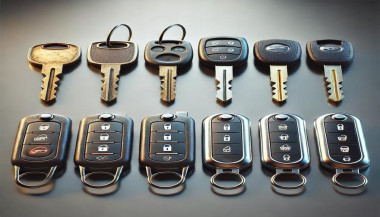Your car key fob is one of the most used items in your daily life. You press it multiple times a day, carry it in your pocket or bag, toss it on desks, and sometimes accidentally drop it on the ground. But how often do you actually clean or check it?
Most people only think about their key fob when it stops working. By then, it's often too late. The good news is, with a little attention and regular maintenance, you can keep your car key fob working perfectly for years to come.
In this article, you'll learn how to clean and maintain your car key fob like a pro — so you can save money, avoid frustration, and get the best performance out of your key.
Why Cleaning and Maintaining Your Key Fob Matters
Car key fobs aren’t just simple remotes. They're packed with sensitive electronics, small batteries, and tiny contact points that can easily get damaged by dirt, moisture, or simple neglect.
If you never clean or check your key fob, you might start to notice:
Unresponsive buttons
Reduced signal range
Frequent battery issues
Complete failure to unlock or start the car
Most of these problems are avoidable with basic maintenance. Cleaning your key fob regularly helps keep it functional, protects its electronics, and ensures it lasts longer. It also saves you from spending money on costly repairs or total key replacements.
How to Clean Your Car Key Fob: Step-by-Step Guide
Step 1: Open the Key Fob Gently
Start by carefully opening your key fob. Most models have a small groove or notch where you can insert a flathead screwdriver or a coin to separate the shell. Be gentle — forcing it open can crack the plastic or damage internal clips.
If you're unsure, check your car’s manual or look up your key model online to find specific instructions.
Step 2: Remove the Battery
Once you open the key fob, always remove the battery before cleaning. This protects the electronic circuit from any accidental moisture and prevents short-circuiting.
Set the battery aside in a dry, safe place.
Step 3: Clean the Exterior
Use a soft, dry microfiber cloth to wipe the outside of the key fob shell. For tougher dirt or sticky areas, slightly dampen the cloth with water or isopropyl alcohol (70% or higher). Avoid using harsh cleaning chemicals that could damage the plastic or remove painted symbols.
Step 4: Clean the Buttons and Small Gaps
Dirt, dust, and pocket debris often collect around the buttons. These particles can block the buttons from making proper contact or cause them to stick.
Use a cotton swab or a soft toothbrush to gently clean around the edges and in between the buttons. For tight spaces, a toothpick can help dislodge stubborn dirt. If needed, lightly moisten the cotton swab with alcohol to break down grime.
Always dry the key fob thoroughly after cleaning.
Step 5: Inspect and Clean the Battery Contacts
Battery contacts can become dirty or corroded over time, especially if the battery leaked or moisture got inside.
Check the metal contact points carefully. If you see white powder or greenish residue (common signs of corrosion), gently clean them using a cotton swab dipped in isopropyl alcohol. Be extremely careful not to bend or scratch the contacts.
If corrosion is too severe, the key fob might need professional repair or a replacement circuit board.
Step 6: Replace the Battery if Needed
Key fob batteries typically last between 1 to 2 years, but frequent use, weak signals, or exposure to extreme temperatures can shorten battery life.
If your battery is old or low, replace it with a new one. Most car key fobs use CR2032 or CR2025 batteries. Always make sure you install the new battery in the correct position, respecting the polarity (+ / -).
A fresh battery not only improves response time but also ensures the signal reaches your car reliably.
Step 7: Reassemble the Key Fob
Once everything is clean and fully dry, carefully snap the key fob back together. Make sure the casing is securely closed and the buttons feel smooth and responsive.
Test the key fob to confirm that it works correctly.
Pro Tips to Keep Your Car Key Fob in Top Shape
A well-maintained key fob can last many years. Here’s how to keep it working perfectly:
Keep it Dry: Most key fobs aren’t waterproof. Avoid rain, puddles, wet pockets, or any contact with liquids.
Use a Protective Cover: A silicone or rubber key cover adds shock protection, keeps out dirt, and prevents scratches.
Avoid Extreme Heat or Cold: Leaving your key fob in direct sunlight or in a freezing car can damage the battery and weaken plastic parts.
Change the Battery Regularly: Don’t wait for your key fob to completely stop working. Weak batteries can lead to unreliable signals and unexpected failure.
Don’t Drop It: Even though most key fobs can handle light drops, repeated impact can cause internal damage.
When to Replace the Key Fob Shell
If your key fob shell is cracked, worn, or no longer closes tightly, it’s time to replace it. A damaged shell can let moisture and dirt reach the electronics and cause long-term damage.
Replacing the shell is a quick and affordable solution that can extend your key fob’s life significantly.
At Mr. Key, we offer high-quality key fob shells, batteries, and repair kits that can help you refresh your key fob and save money compared to dealership prices.
Explore our key fob repair kits, protective covers, and replacement batteries now at mr-key.com.
Your car key fob may seem like a small detail, but it plays a huge role in your daily life. Without it, you can’t get in or even start your car.
The good news is that taking care of your key fob is easy. With regular cleaning, battery checks, and some simple maintenance, you can keep it working reliably for years.
And if you need to replace your battery, your key shell, or your entire key fob, Mr. Key is here to help.
We provide everything you need to keep your keys in perfect shape, save money, and avoid unnecessary trips to the dealer.

_1751630541.jpg)



_1733224387.jpg)